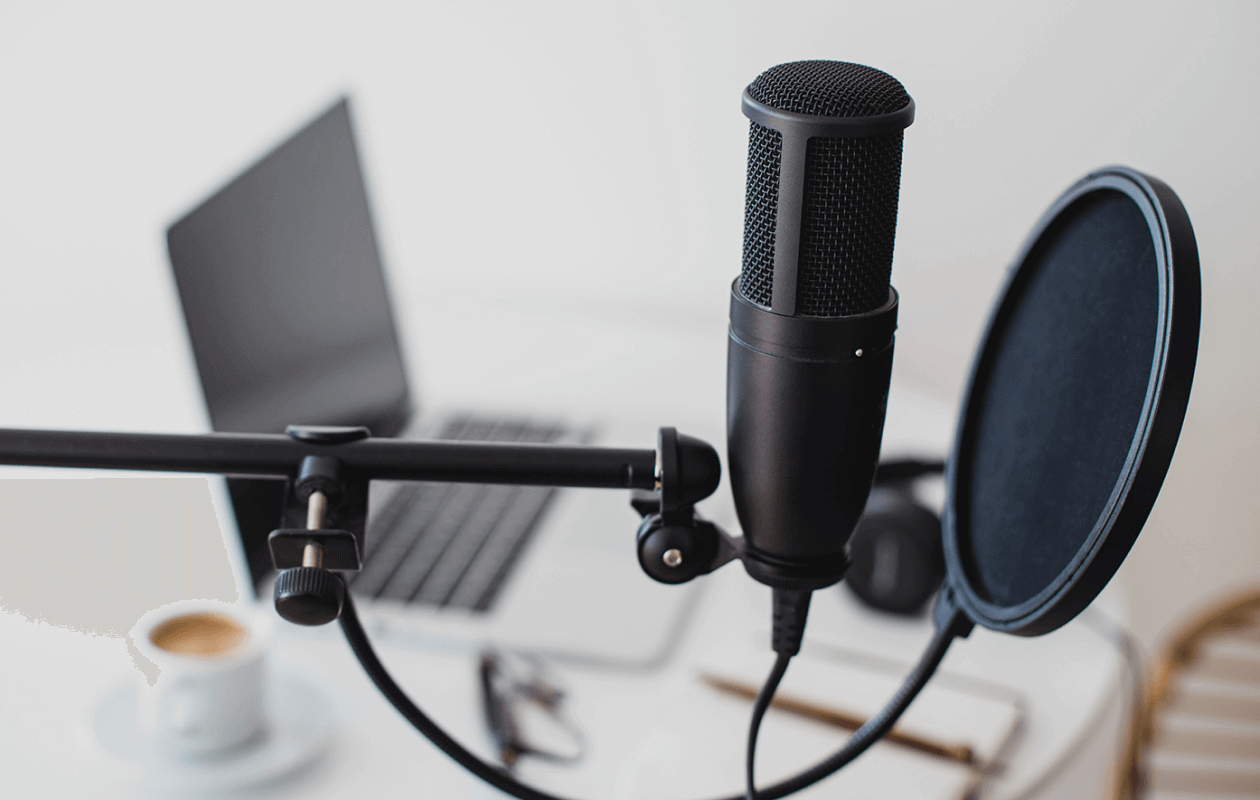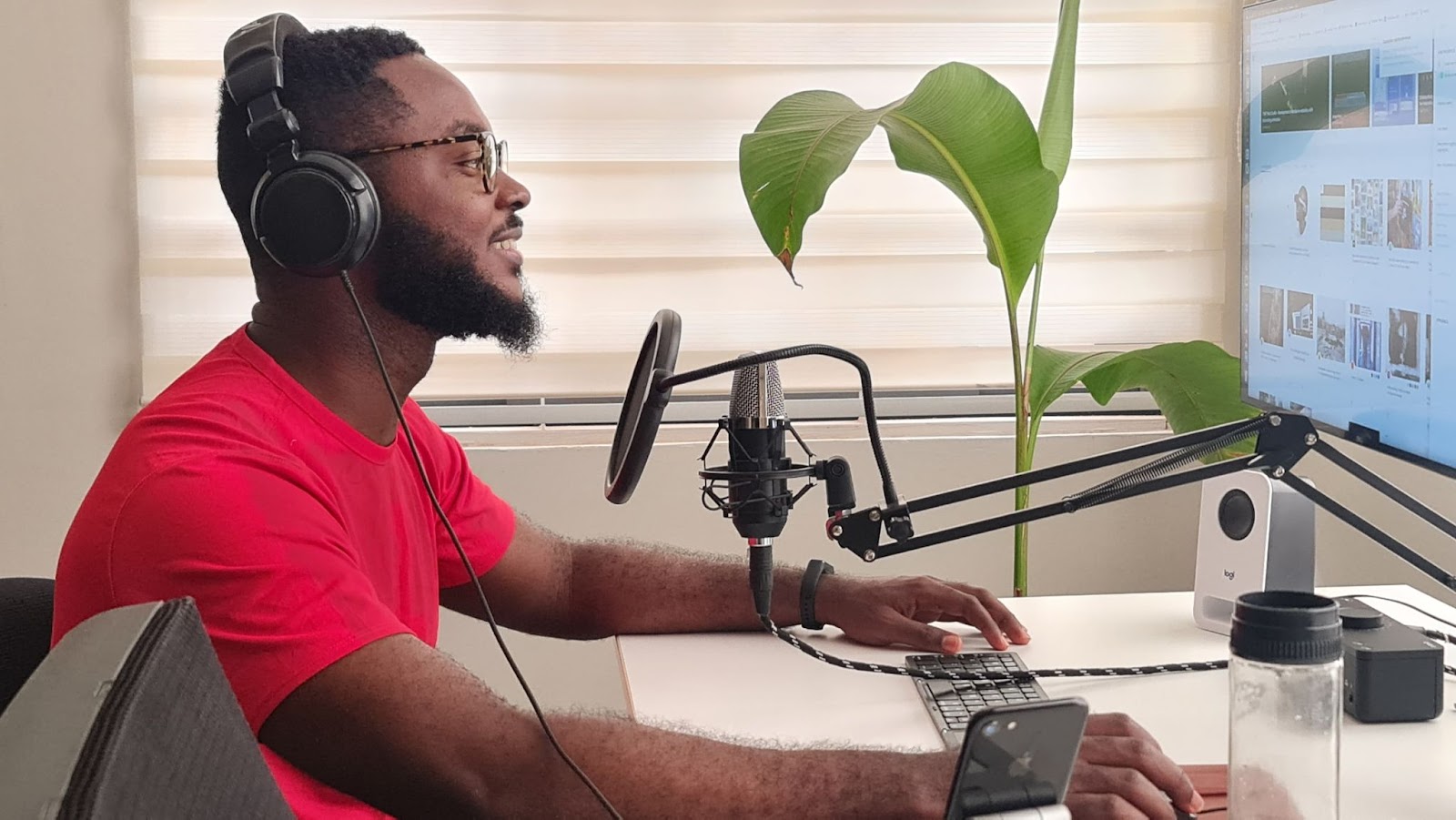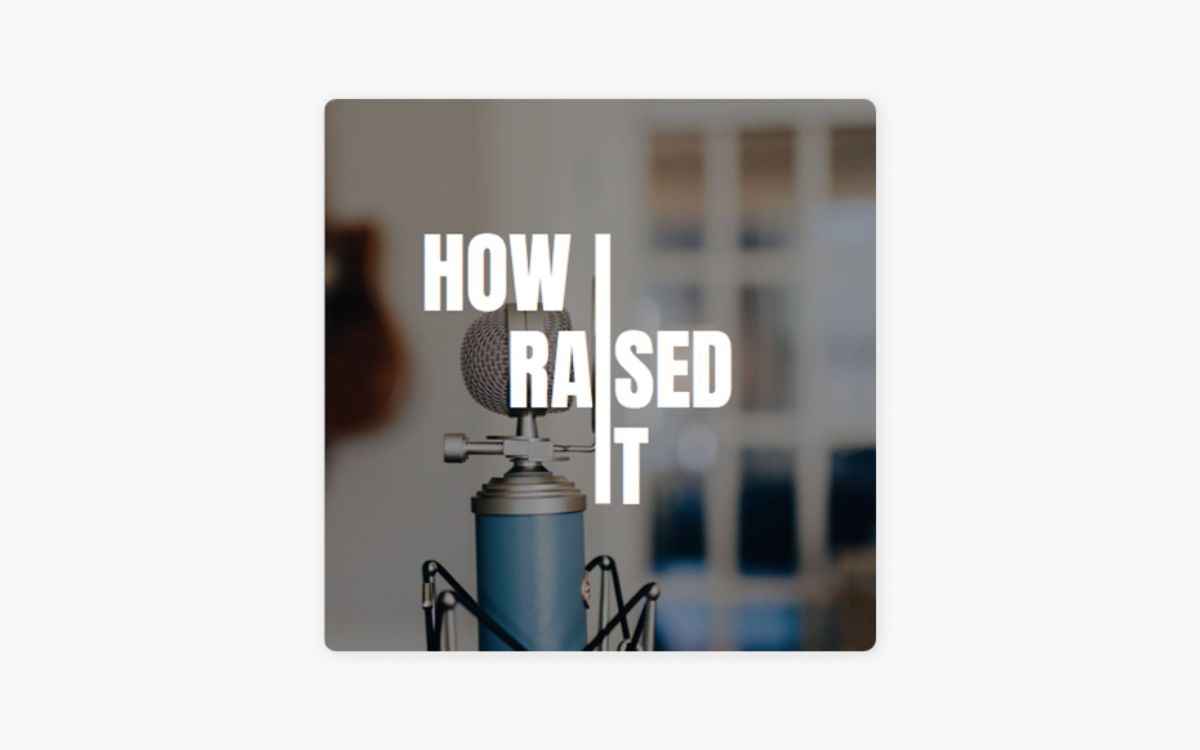Home>Events & Info>Podcast>How Can I Make A Podcast


Podcast
How Can I Make A Podcast
Modified: February 17, 2024
Learn how to make a podcast from scratch and gain valuable tips on recording, editing, and promoting your podcast. Start your podcasting journey today!
(Many of the links in this article redirect to a specific reviewed product. Your purchase of these products through affiliate links helps to generate commission for AudioLover.com, at no extra cost. Learn more)
Table of Contents
- Introduction
- Step 1: Choosing a Topic
- Step 2: Planning Your Podcast
- Step 3: Gathering Equipment
- Step 4: Recording Your Podcast
- Step 5: Editing Your Podcast
- Step 6: Creating Podcast Artwork
- Step 7: Choosing a Podcast Hosting Platform
- Step 8: Publishing and Distributing Your Podcast
- Step 9: Promoting Your Podcast
- Conclusion
Introduction
Welcome to the world of podcasting! In recent years, podcasts have gained immense popularity, becoming a powerful medium for entertainment, education, and storytelling. Whether you’re an aspiring influencer, a passionate expert in a particular field, or simply someone who loves to share their thoughts and experiences, creating a podcast can be a rewarding and fulfilling endeavor.
But where do you start? How can you make a podcast that stands out from the crowd and captivates your audience? In this comprehensive guide, we’ll take you through the step-by-step process of creating and launching your own podcast.
Before we dive in, let’s briefly discuss what a podcast is and why it has become such a widespread phenomenon. A podcast is an audio-based show, similar to a radio program, that is made available for streaming or downloading on the internet. Podcasts cover a wide range of topics, from true crime and comedy to business, technology, and personal development. Podcasts offer the convenience of on-demand listening, allowing audiences to tune in whenever and wherever they want.
One of the reasons why podcasts have gained traction is their accessibility. With the rise of smartphones and mobile apps, people can easily subscribe to their favorite podcasts and listen to them while commuting, working out, or doing household chores. The intimate nature of audio also provides a more personal and immersive experience compared to other forms of content.
Creating a podcast can be a fantastic way to share your knowledge, passion, or unique perspective with the world. It allows you to connect with like-minded individuals, build a community, and even monetize your content. But, like any creative endeavor, it requires careful planning and execution. In the following sections, we’ll break down each step of the podcast creation process, providing you with tips and guidance to ensure your podcast sounds professional and resonates with your target audience.
So, if you’re ready to embark on this exciting podcasting journey, let’s get started with step one: choosing a topic for your podcast.
Step 1: Choosing a Topic
Choosing the right topic for your podcast is crucial, as it forms the foundation of your entire show. The topic should align with your interests, expertise, and the preferences of your target audience. Here’s how you can go about selecting the perfect podcast topic:
1. Identify Your Passion and Expertise: Start by brainstorming topics that you are genuinely passionate about. Think about your hobbies, professional background, or any niche areas you have specialized knowledge in. Having enthusiasm and expertise in the subject matter will not only make the podcast creation process more enjoyable for you but also ensure that you can provide valuable and engaging content to your listeners.
2. Research Market Demand: While it’s important to follow your passion, it’s also essential to assess the market demand for your chosen topic. Look for existing podcasts in your niche and see how popular they are. Are there already many shows covering the same topic or is there a gap that you can fill? Analyzing the market will help you determine if there is an audience for your podcast and if there is potential for growth.
3. Define Your Target Audience: Understanding who your target audience is will help you narrow down your topic and tailor your content to their needs and interests. Consider their demographics, interests, and pain points. This will not only guide your topic selection but also help you create content that resonates with your audience and keeps them coming back for more.
4. Be Specific and Unique: It’s important to find a balance between choosing a niche topic and being too broad. While a broad topic like “health and wellness” might seem appealing, it can be challenging to stand out in a saturated market. Instead, try to narrow it down to a specific subtopic that sets you apart, such as “mindfulness practices for busy professionals” or “nutrition for athletes.” Being specific and unique will help you attract a dedicated audience who are specifically interested in what you have to offer.
5. Consider Longevity: When choosing a podcast topic, think about its long-term potential. Is it something you can consistently create episodes for, or will you run out of ideas after a few weeks? Consider whether the topic has enough depth and scope to keep your podcast going for the long haul.
6. Test the Waters: Before fully committing to a topic, consider creating a pilot or a few test episodes to gauge audience interest and gather feedback. This will allow you to fine-tune your concept and make any necessary adjustments before diving into full-scale production.
Remember, choosing the right topic is essential for building an engaged audience and sustaining your podcast in the long run. Take the time to carefully consider your interests, market demand, and target audience to find a topic that excites you and has the potential to resonate with listeners.
Step 2: Planning Your Podcast
Once you have chosen a topic for your podcast, it’s time to start planning the structure and format of your show. A well-thought-out plan will ensure that your episodes flow smoothly and engage your audience effectively. Here are some key steps to consider when planning your podcast:
1. Determine the Episode Format: Decide on the format that best suits your topic and audience. Will it be an interview-style show, a solo monologue, or a roundtable discussion? Think about what will work best for delivering your content and engaging your listeners. You can also consider mixing different formats to keep your podcast dynamic and varied.
2. Outline Each Episode: Before recording, create a detailed outline for each episode. Break down the main points you want to cover and consider the order in which you will present them. This will help you stay organized and ensure that your episodes have a logical flow. It also helps prevent any awkward transitions or rambling tangents during recording.
3. Set an Episode Length: Decide how long each episode will be and stick to a consistent length. Whether it’s 30 minutes or an hour, having a predictable episode duration helps your listeners know what to expect and allows you to plan your content accordingly. Keep in mind that shorter episodes are often more digestible for busy listeners, while longer episodes can provide more in-depth discussions.
4. Create Segment Ideas: Consider incorporating segments into your episodes to provide structure and variety. Segments can include Q&A sessions, listener shout-outs, guest interviews, or recurring topics. These segments help make your podcast more engaging and give listeners something to look forward to each episode.
5. Develop an Episode Schedule: Determine how frequently you will release new episodes. This could be weekly, bi-weekly, or even monthly. Consistency in your release schedule is key to building a loyal audience. It also helps you plan and manage your podcast production workflow effectively.
6. Script and Rehearse: While you don’t necessarily need to script every word, having a script or outline can help guide your content and ensure that you cover all the essential points. Additionally, rehearsing your episodes before recording can help you fine-tune your delivery, reduce mistakes, and improve the overall quality of your podcast.
7. Prepare Show Notes: Show notes are written summaries of each episode that provide additional context, links, and resources for your listeners. Take the time to prepare comprehensive show notes to enhance the listening experience and provide valuable information that your audience can refer to.
By carefully planning your podcast, you can create a cohesive and engaging listening experience for your audience. Remember to choose a format that suits your topic, outline your episodes, and establish a consistent length and release schedule. With a solid plan in place, you’ll be well-prepared to start recording your podcast in the next step.
Step 3: Gathering Equipment
Now that you have planned the structure and format of your podcast, it’s time to gather the necessary equipment to ensure high-quality audio recordings. While you don’t need expensive professional gear to start, having some essential equipment will greatly improve the overall sound of your podcast. Here are the key items to consider:
1. Microphone: Invest in a decent microphone to ensure clear and crisp audio. USB microphones like the Blue Yeti or Audio-Technica ATR2100x are popular options for beginner podcasters. If you’re looking for a more professional setup, consider a dynamic microphone like the Shure SM58 or the Audio-Technica AT2020.
2. Pop Filter or Windscreen: To reduce plosive sounds and balance your vocal recordings, use a pop filter or a windscreen. These accessories help minimize the harsh “p” and “s” sounds that can distort your audio quality.
3. Headphones: Invest in a good pair of closed-back headphones to monitor your audio while recording and editing. This allows you to catch any audio issues and ensure a consistent sound throughout your episodes.
4. Boom Arm or Mic Stand: A boom arm or a mic stand helps position your microphone at the proper height and angle for comfortable recording. It also minimizes handling noise and vibrations that could affect the audio quality.
5. Audio Interface (Optional): If you’re using an XLR microphone, you’ll need an audio interface to connect it to your computer. The Focusrite Scarlett series or the PreSonus AudioBox are popular options for entry-level podcasters.
6. Acoustic Treatment (Optional): To improve the audio quality in your recording space, consider adding some basic acoustic treatment. This can include foam panels or diffusers on the walls to reduce echo and background noise. However, if you’re just starting out, recording in a quiet room with minimal ambient noise can suffice.
7. Recording Software: Choose a recording software that best suits your needs. Audacity and GarageBand are popular, free options for beginners. For more advanced features, consider software like Adobe Audition or Reaper.
8. Pop Filter or Windscreen: To reduce plosive sounds and balance your vocal recordings, use a pop filter or a windscreen. These accessories help minimize the harsh “p” and “s” sounds that can distort your audio quality.
Remember, while having good equipment is important, it’s equally essential to create a quiet and controlled recording environment. Choose a room with minimal background noise, such as a closet filled with clothes or a dedicated home office. You can improve the acoustics further by adding blankets or foam panels to absorb echo and reverberation.
With the right equipment in hand, you’ll be ready to move on to the next step: recording your podcast.
Step 4: Recording Your Podcast
Now that you have gathered the necessary equipment, it’s time to start recording your podcast. The quality of your recordings will play a significant role in the overall success of your podcast. Here are some essential tips for a smooth recording process:
1. Choose the Right Recording Software: Open your chosen recording software and ensure that your microphone is selected as the input device. Adjust the input levels to avoid distorting or clipping the audio.
2. Find a Quiet Environment: Find a quiet space to record your episodes. Close windows, turn off fans or air conditioners, and minimize any sources of background noise. Consider using blankets or foam panels to reduce echo and improve the overall sound quality.
3. Position Your Microphone: Position your microphone correctly for optimal sound capture. Sit about 6-8 inches away from the microphone, keeping it at a 45-degree angle from your mouth. Use a pop filter or windscreen to minimize plosive sounds.
4. Test and Adjust Levels: Before diving into the main recording, do a test recording to check the audio levels. Speak naturally into the microphone and adjust the gain or input levels to ensure a balanced volume. Aim for a consistent audio level throughout your podcast.
5. Speak Clearly and Slowly: Speak clearly and at a moderate pace to ensure clarity in your recordings. Avoid speaking too fast or mumbling. Take brief pauses between sentences to give your listeners time to absorb the information.
6. Use Vocal Techniques: Use vocal techniques to maintain a dynamic and engaging delivery. Vary your tone, use emphasis where appropriate, and inject enthusiasm and personality into your voice. This will help keep your audience engaged and interested in your podcast.
7. Minimize Background Noise: Try to minimize any background noise during recording. Silence cell phones, remove noisy accessories, and inform others around you about recording time to avoid interruptions.
8. Record Backup Tracks: Consider recording a backup track in case any issues arise during the main recording. This can help you avoid losing an entire episode due to technical glitches or other unforeseen circumstances.
9. Take Breaks: If you’re recording a lengthy episode, don’t be afraid to take short breaks to rest your voice and gather your thoughts. This will help maintain energy and prevent fatigue.
10. Edit Out Mistakes: It’s normal to make mistakes while recording. Don’t worry and keep going. You can edit out any mistakes, awkward pauses, or tangents during the editing process.
Remember, practice makes perfect. The more you record, the more comfortable you will become with the process. Be patient and keep refining your skills to deliver high-quality recordings for your podcast.
Step 5: Editing Your Podcast
Editing is a crucial step in the podcast production process that helps polish your recordings and create a professional and engaging final product. While editing may seem daunting at first, with the right tools and techniques, you can effectively enhance your podcast episodes. Here’s how to approach the editing process:
1. Choose the Right Editing Software: Select an editing software that suits your needs and skill level. Popular options include Audacity (free), Adobe Audition, and GarageBand (for Mac users). Familiarize yourself with the software interface and basic editing functions.
2. Import Your Recording: Import the recording or audio files into your editing software. Create a new project and organize your tracks, making it easy to navigate and work with different elements of your podcast.
3. Review and Remove Unwanted Noise: Listen to your recording carefully and remove any background noise, clicks, pops, or hisses using noise reduction tools. This step helps enhance the clarity and quality of your audio.
4. Cut Out Mistakes and Pauses: Scan through the recording and edit out any mistakes, long pauses, or repetitive sections. Smooth out the flow by tightening up the dialogue and removing any unnecessary tangents or digressions.
5. Add Music, Intros, and Outros: Enhance your podcast with the right music, intros, and outros. Import your chosen music tracks and place them strategically throughout the episode, including at the beginning and end. This adds a professional touch and sets the tone for your podcast.
6. Adjust Volume Levels: Ensure that the audio levels are consistent throughout your episode. Adjust the volume levels using the editing software’s tools to maintain a pleasant listening experience without any drastic volume differences between segments or speakers.
7. Apply Equalization and Compression: Use equalization (EQ) to balance the frequencies and make your voices sound natural. Apply compression to even out the dynamics of the audio and make it more consistent. Experiment with these effects to find the best settings for your podcast.
8. Incorporate Segments and Sound Effects: If you have planned any segments or want to add sound effects, do so during the editing process. This helps break up the episode and keeps the listener engaged. Ensure that the transitions are smooth and seamless.
9. Export the Final Episode: Once you have completed the editing process, export the final episode as a high-quality audio file. Consider using lossless formats like WAV or AIFF for the best audio fidelity.
10. Listen and Review: Before publishing your episode, listen to the edited version in its entirety. Take notes and make any necessary adjustments to ensure the overall quality and coherence of your podcast.
Remember, editing is an iterative process, and it may take time to develop your skills. As you gain experience, you’ll become more efficient and proficient in editing your podcast episodes. Take your time and aim for a polished and professional final product.
Step 6: Creating Podcast Artwork
Creating compelling and eye-catching podcast artwork is essential for attracting potential listeners and creating a memorable brand for your show. Your podcast artwork serves as a visual representation of your podcast and can significantly impact its overall appeal. Here’s how you can create captivating podcast artwork:
1. Determine the Design Concept: Start by brainstorming the design concept that aligns with your podcast’s theme, topic, and target audience. Consider the mood and tone you want to convey. Will it be bold and energetic, or calm and serene? Reflect on your podcast’s unique selling point and try to capture it visually.
2. Choose the Right Dimensions: Research the recommended dimensions for podcast artwork, as they can vary across different platforms. Generally, square dimensions around 1400 x 1400 pixels work well. Ensure that your artwork is still easily recognizable at smaller sizes.
3. Use Engaging Graphics and Imagery: Incorporate visually appealing graphics, illustrations, or high-resolution images that represent your podcast’s topic or resonate with your target audience. This will help potential listeners make an instant connection with your show.
4. Select a Color Scheme: Choose a color scheme that reflects the mood and tone of your podcast. Consider using colors that evoke the desired emotions or align with your branding. Ensure that the colors you select are visually appealing and harmonious.
5. Create a Captivating Title and Subtitle: Include your podcast’s title and subtitle in your artwork. Choose a font and size that are legible and visually appealing. Experiment with different typography styles to find the one that best represents your podcast’s personality.
6. Design with Simplicity in Mind: Avoid clutter and keep your design clean and simple. Make sure that the main elements of your artwork are easy to understand at a glance. Too many details can make the artwork overwhelming and difficult to comprehend, especially in small thumbnail sizes.
7. Add Your Branding Elements: Incorporate your logo or brand elements into your podcast artwork to strengthen your brand identity. This helps in building recognition and consistency across your podcast and other promotional materials.
8. Consider High Contrast: Ensure that there is sufficient contrast between the foreground and background elements of your artwork. This will make it easier for your podcast artwork to stand out and grab attention, even when displayed in a small thumbnail size.
9. Get Feedback: Once you have created your initial podcast artwork, seek feedback from friends, colleagues, or your target audience. Their insights can help you refine and improve the design before finalizing it.
10. Save in Appropriate File Formats: After finalizing your podcast artwork, save it in the appropriate file formats, such as JPEG or PNG, for different platforms and devices. This ensures that your artwork is compatible and displays correctly across various podcast directories and platforms.
Remember, your podcast artwork is often the first impression potential listeners have of your show. It should be visually appealing, represent your podcast’s theme effectively, and entice people to click and listen. Take the time to create engaging and professional artwork to set your podcast apart from the competition.
Step 7: Choosing a Podcast Hosting Platform
Once you’ve created your podcast episodes, it’s time to choose a reliable podcast hosting platform. A podcast hosting platform is an online service that stores and distributes your podcast episodes to various podcast directories and platforms. Here’s how to choose the right podcast hosting platform:
1. Consider Pricing and Plans: Compare different hosting platforms and their pricing structures. Look for a plan that suits your budget and offers the features you need. Some hosting platforms offer free plans with limited storage and functionality, while others provide more robust options for a fee.
2. Storage and Bandwidth: Evaluate the storage and bandwidth limits offered by each hosting platform. Consider your podcast’s needs, such as the number and length of episodes you plan to upload. Ensure that the hosting platform provides sufficient storage and bandwidth to support your podcast’s growth.
3. Distribution to Podcast Directories: Check which podcast directories and platforms the hosting platform supports. You want your podcast to be accessible to a wide audience, so ensure that the platform distributes your episodes to popular directories like Apple Podcasts, Spotify, Google Podcasts, and Stitcher.
4. Analytics and Statistics: Look for hosting platforms that provide detailed analytics and statistics about your podcast’s performance. This includes metrics like downloads, listener demographics, and episode popularity. Analytics can help you understand your audience and make data-driven decisions to improve your podcast.
5. Monetization Options: If monetization is a goal for your podcast, investigate if the hosting platform offers monetization features such as dynamic ad insertion or sponsorship opportunities. Some hosting platforms have built-in monetization options or partnerships with advertising networks.
6. Customization and Branding: Consider the level of customization and branding options the hosting platform offers. Can you customize the podcast’s webpage or embed the player on your own website? The more flexibility you have, the better you can align your podcast’s brand with your overall branding strategy.
7. Ease of Use and User Interface: Evaluate the user interface and ease of use of each hosting platform. You’ll be using the platform to upload and manage your episodes, so it’s important that it’s intuitive and user-friendly. Consider the platform’s dashboard and features while making your decision.
8. Customer Support: Look for hosting platforms that offer reliable customer support. Whether it’s via email, live chat, or phone, having accessible and responsive support can be invaluable when you encounter technical issues or need assistance with your podcast.
9. Scalability: Consider the scalability of the hosting platform. Can it accommodate your podcast’s growth in terms of storage, bandwidth, and features? It’s essential to choose a hosting platform that can grow with your podcast and support your future needs.
10. Reviews and Recommendations: Do your research and read reviews or seek recommendations from other podcasters. Their experiences and insights can provide valuable information and help you make an informed decision.
Choosing the right podcast hosting platform is crucial for the success of your podcast. Take the time to evaluate your options, consider your podcast’s specific needs, and select a hosting platform that meets your requirements and aligns with your goals.
Step 8: Publishing and Distributing Your Podcast
Now that you have chosen a podcast hosting platform, it’s time to publish and distribute your podcast to reach a wider audience. Publishing and distributing your podcast involves submitting your show to various podcast directories and promoting it to attract listeners. Here’s how to effectively publish and distribute your podcast:
1. Upload Your Episodes: Use your chosen podcast hosting platform to upload your episodes. Make sure to provide all the necessary details for each episode, including the episode title, description, and any relevant metadata.
2. Create an Attractive Podcast Page: Utilize the customization options provided by your hosting platform to create an appealing podcast page. Customize the page with your podcast artwork, show description, and any additional information you want to include. Craft a compelling podcast description that entices potential listeners and accurately represents your show.
3. Submit to Podcast Directories: Submit your podcast to popular podcast directories such as Apple Podcasts, Spotify, Google Podcasts, and Stitcher. Each directory has its own submission process, so follow the guidelines provided by each platform to get your podcast listed.
4. Optimize Your Podcast for SEO: Pay attention to search engine optimization (SEO) for your podcast. Use relevant keywords in your podcast title, description, and episode titles to ensure better visibility in search results. This helps potential listeners discover your podcast when searching for related topics.
5. Promote Your Podcast on Social Media: Leverage social media platforms to promote your podcast. Create dedicated social media accounts for your podcast and engage with your audience. Share episode highlights, behind-the-scenes content, and encourage listeners to subscribe and share your episodes.
6. Collaborate with Other Podcasts: Reach out to other podcasters in your niche and explore opportunities for collaboration, such as joint episodes, guest appearances, or cross-promotion. Collaborating with other podcasters can help you tap into their audience and expand your reach.
7. Encourage Reviews and Ratings: Request reviews and ratings from your listeners. Positive reviews and ratings not only boost your podcast’s credibility but also improve its visibility in podcast directories. Promote reviews through call-to-action messages during your episodes or on your podcast page.
8. Repurpose Your Content: Repurpose your podcast episodes into other forms of content to reach different audiences. Consider creating blog posts, YouTube videos, or social media snippets that highlight key insights or discussions from your episodes.
9. Engage with Your Audience: Foster a sense of community and engage with your audience by responding to comments, messages, and emails. Encourage listeners to send in questions or topic suggestions, and feature their input in future episodes. Building a loyal and engaged community will help drive listenership and growth.
10. Monitor Your Podcast Analytics: Regularly track and analyze your podcast analytics from your hosting platform. Pay attention to demographic information, download trends, and episode performance. This data will provide insights into your audience’s preferences and help you make informed decisions to improve your podcast.
Remember, publishing and distributing your podcast is an ongoing process. Stay consistent with your episode releases, explore new promotional strategies, and continuously engage with your audience to build a loyal listener base and grow your podcast’s reach.
Step 9: Promoting Your Podcast
Promoting your podcast is key to reaching a wider audience and building a dedicated listener base. Effective promotion helps increase visibility, attract new listeners, and ultimately grow the success of your podcast. Here are some essential tips to promote your podcast:
1. Leverage Your Existing Network: Start by promoting your podcast to your existing network of friends, family, and colleagues. Share it on your personal social media accounts, email newsletters, or personal blog to spread the word and encourage them to listen and share with their networks.
2. Utilize Social Media Platforms: Create dedicated social media accounts for your podcast on platforms like Twitter, Facebook, Instagram, or LinkedIn. Consistently share episode updates, behind-the-scenes content, engaging visuals, and quotes from your episodes. Engage with your audience by responding to comments and messages.
3. Participate in Podcasting Communities: Join podcasting communities and forums to connect with fellow podcasters and listeners. Engage in conversations, share your expertise, and promote your podcast when appropriate. These communities can provide valuable insights, collaborations, and cross-promotion opportunities.
4. Guest Appearances on Other Podcasts: Seek opportunities to be a guest on other podcasts in your niche. This allows you to tap into their established audience and showcase your expertise. Provide valuable insights and engage with the host and audience, leaving an impression that encourages listeners to explore your podcast.
5. Cross-Promotion with Other Podcasts: Collaborate with other podcasters to cross-promote each other’s shows. This can be through joint episodes, swap interviews, or simply promoting each other’s podcasts to your respective audiences. This strategy helps expand your reach and introduce your podcast to new listeners.
6. Utilize Email Marketing: Build an email list of your podcast’s subscribers and engage with them regularly through email newsletters. Send updates, episode highlights, exclusive content, or bonus material to keep your subscribers engaged and excited about your podcast.
7. Guest Blogging and Writing Articles: Write guest blog posts or articles for websites and publications related to your podcast’s niche. Include links to your podcast in your author bio or within the content itself, driving traffic and exposure to your show. Sharing your knowledge in written form can establish you as an expert and attract new listeners.
8. Attend Events and Conferences: Look for podcasting events or conferences in your area and attend them to network with other podcasters and industry professionals. Participate in panel discussions or workshops to share your expertise and promote your podcast to a targeted audience.
9. Collaborate with Influencers: Identify influencers or experts in your podcast’s niche and reach out to them for collaboration opportunities. This can include interviews, guest appearances, or social media shout-outs. Having influencers endorse your podcast can significantly expand your reach and credibility.
10. Seek Reviews and Ratings: Encourage your listeners to leave reviews and ratings for your podcast on platforms like Apple Podcasts or Podchaser. Positive reviews not only boost your podcast’s visibility but also showcase social proof to potential listeners.
Remember, promotion is an ongoing effort. Consistency and strategic promotion across various channels will yield the best results. Keep experimenting with different promotion strategies, track their effectiveness, and adapt your approach as needed to maximize your podcast’s growth.
Conclusion
Congratulations! You have completed the comprehensive journey of creating, recording, editing, and promoting your podcast. By following these steps, you have set yourself up for success in the podcasting world. However, the journey doesn’t end here. Continuing to refine your skills, engage with your audience, and deliver compelling content is crucial for the long-term success of your podcast.
Remember that consistency is key. Regularly release new episodes on a reliable schedule to keep your audience engaged and coming back for more. Listen to feedback from your listeners and constantly strive to improve the quality and relevance of your content.
Utilize the power of social media to foster a strong community around your podcast. Interact with your listeners, respond to comments and messages, and create engaging content that sparks conversations, encourages sharing, and builds a loyal following.
Explore collaborations with other podcasters and influencers in your niche. By joining forces, you can tap into each other’s audience and reach new listeners who share similar interests. Cross-promotion and guest appearances can be valuable tools for expanding your reach and gaining credibility in the podcasting space.
Stay informed about trends and changes in the podcasting landscape. Be adaptable and open to adopting new technologies, platforms, and promotional strategies that can enhance your podcast’s visibility and success. Embrace feedback and constantly seek opportunities for growth and improvement.
Finally, enjoy the journey! Podcasting is a creative and fulfilling endeavor that allows you to share your passions, connect with like-minded individuals, and make a positive impact. Remember why you started your podcast in the first place and let that passion drive you forward.
With dedication, perseverance, and the knowledge gained from this guide, you are ready to make your mark in the podcasting world. So, go ahead and tell your stories, share your expertise, and inspire your audience. Happy podcasting!











